czq
17

Sharing some additional information about the other models in the Collection
14 years ago at the turn of the millennium, Seiko launched a collection of 7 watches in Japan.
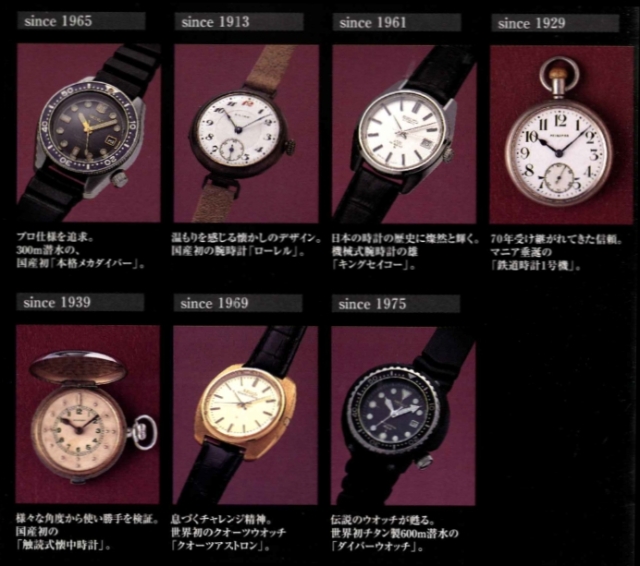
These were meant to be re-issues of significant watches in their watch making history. Choices had to be made, and no doubt certain watches had to be left out, which to some collectors ought to be included, and these included the world’s first automatic chronograph 6139 watches, the world’s first quartz analogue chronograph 7AX8 watches and the world’s first watch driven by body heat alone.
To-date, these 7 watches remain rarely discussed on watch forums and hardly spotted on resale markets. Having recently gotten into touch with some fine examples of these watches, and due to the lack of information about this collection on the Web, I decided to do some research and share my information.
I would say that the releases of the 2 divers are the most frequently discussed and seen on resale markets, which was also how I got to know about the Seiko Historical Collection 2000 in the first place. The other models are as rare as hen’s teeth.
The 7 watches in the Seiko Historical Collection 2000 include:
1) SBDX003 8L35 Diver’s 300M -200,000 yen/USD 1,900 June 2000 (500 pieces)
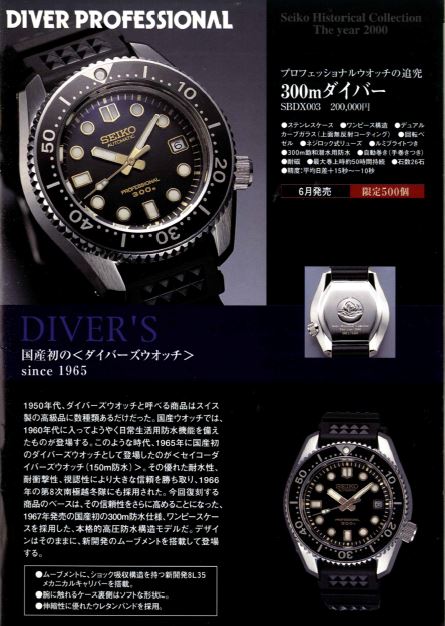
Nothing much needs to be said about this as everyone will be familiar with the SBDX001 (otherwise known as the MM300) which is the non limited edition variant of this release, which is itself a descendant from the 36,000 bph 61 cal powered diver. Other than the gold accents used on the hour markers, hands and printing, this variant only came with a rubber strap, unlike the MM300 which comes equipped with both a rubber strap and metal bracelet.
2) SCVM001 4S28 Laurel – 100,000 yen/USD 920 July 2000 (1000 pieces)

This is a very interesting watch in the sense that the “Laurel” branding had actually been used to launch a series of mechanical watches in the mid 1990s. You can see the full range of Laurel watches launched in the mid 1990s here. However unlike the Laurel launched a few years before the Historical Collection 2000, this Laurel follows the historic Laurel pretty accurately, down to the fixed wire lugs and diameter. This is probably the smallest wrist watch that I have, no more than 32mm across with a fixed lug size of 13mm. It can only be worn with a WW1 style bund strap. The original strap that came with my example had already started flaking due to its age, despite its unworn condition.
It comes with an enamel dial with the hour markers printed neatly on it. Collectors might notice that the 12 hour marker is in black and not red as per the historic Laurel. Seiko subsequently released different models of Laurel (although not branded as such), with the “red 12″ distinction as shown in the picture belonging to a fellow collector below.

3) SCVN001 4S15 King Seiko – 150,000 yen/USD 1,400 August 2000 (2000 pieces)
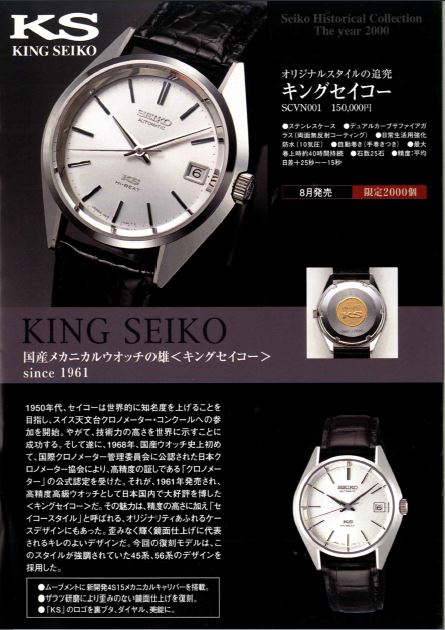
Modern watch collectors would not have known about the King Seiko which was a competitor to the Grand Seiko back in the 1960s and 1970s. Certain King Seikos also shared the same movements as some Grand Seikos and were also Chronometer certified . Seiya-san also believed that the 52 KS was superior to the Grand Seiko at that point in time, not in accuracy but in the overall quality and build. The calibre 52 was subsequently resurrected in the 1990s as the 4S family of movements and can be found in mid-range Seikos until 2000, where it was relegated upwards to Credor and Brightz models. This was believed to be because the 6r movement was finally developed from the basic 7s movement that was capable of powering mid range Seikos in 2005.
Interestingly enough, Seiko re-released a modern interpretation of the King Seiko (KS) but not the Grand Seiko (GS). However this might be due to the fact that the modern Grand Seiko range was launched in 1998, and Seiko did not see the need to confuse consumers with a “re-launch” of a product that, to casual watch collectors, was only released 2 years ago.
Given the fact that this is the ONLY King Seiko released in modern times, using a period appropriate movement (4S15 being the re-named 52 caliber) and finished with a historically accurate case finishing (Grammer of Design) makes this a very valuable model indeed.
4) SCVR001 8L34 Railway Watch – 250,000 yen/USD 2,320 September 2000 (3000 pieces)
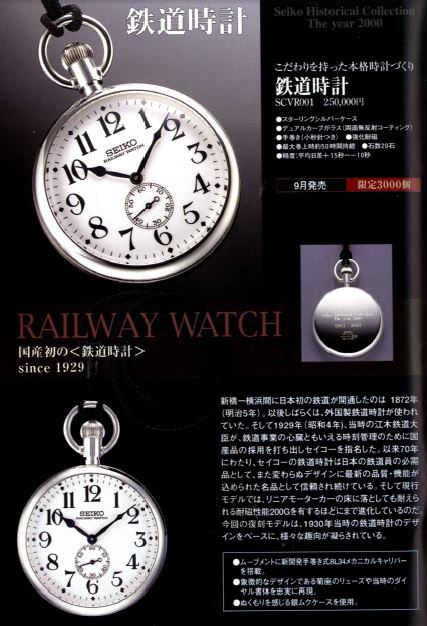
I find this to be the most interesting release in this Historical Collection. This railway watch is powered by the 8L34 movement, which is the only hand winding variant of the 8L movement that I am aware of. This is also the only model that uses this particular variant. (Digression: Interestingly enough, another example where 1 8L Seiko movement appears in only 1 particular watch model is the Credor GCBZ995/999 that uses the 8L36 GMT movement.)
Other than this, I also find it very intriguing that the 2 handwinding only watches in this collection, the Laurel and the Railway watch, uses 2 different handwinding movements. Perhaps this is to signify the variety of movements that Seiko is able to produce or to be in touch with the historical specifications of their predecessors.
Also the Railway Watch is encased in sterling silver and has an enamel dial that resulted in it being the third most pricey watch in the collection. Yet it also enjoyed the highest number of production pieces (3000), compared to the rest which ranged from 500 to 2000.
5) SQBR017 7C17 Pocket Watch -35,000 yen/USD 320 October 2000 (1000 pieces)
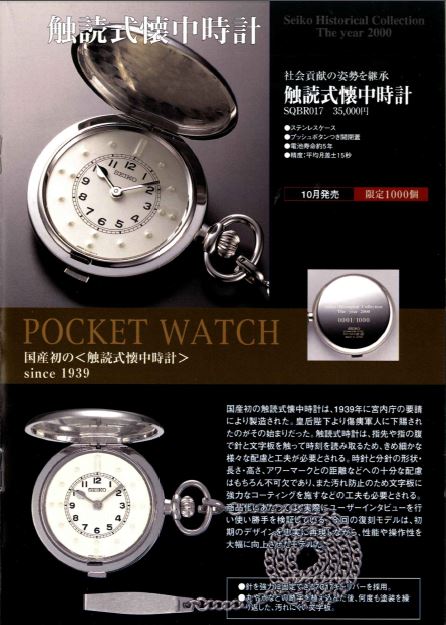
I believe this watch was considered historically significant because it could be used by the visually impaired to tell the time by touch. There is no crystal covering the dial so as to enable the user to tell the time by tracing the hands to the hour markers.
Based on this Japanese sales post, this watch was manufactured in 1939 at the request of the Imperial Household Ministry. It was been bestowed from the Empress to disabled veterans and it was said to be the first domestic “touch pocket watch”.
6) SCQZ002 9F61 Quartz Astron – 700,000 yen/USD 6,320 November 2000 (500 pieces)
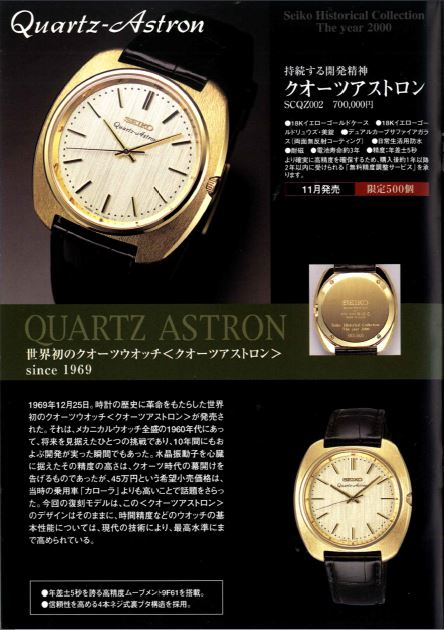
The Astron was the first commercially available quartz wrist watch released on Christmas day (no kidding) in 1969 (also the same year the first automatic chronographs were released). At that time it costs as much as a small car in Japan, having been encased in a solid gold case. Similarly, this Historical Collection Astron also costs as much as a small car when it was released due to the fact that it also comes in a solid gold case. Subsequently in Dec 2009, Seiko released yet another variation of the Astron (LE 200) to commemorate the 40th anniversary of the release of the Astron. This time, it comes in a high intensity titanium alloy case, which made it slightly more affordable. It is also worth noting that the Historical Collection Astron is accurate to +/- 5 sec a year while the 40th Anniversary Astron is accurate to +/- 10 sec a year. Most quartz Grand Seikos contain movement that are accurate to +/- 10 sec a year with only certain special models containing more accurate variants.
7) SBDX005 8L35 Diver’s 600M – 300,000 yen/USD 2,620 December 2000 (1000 pieces)
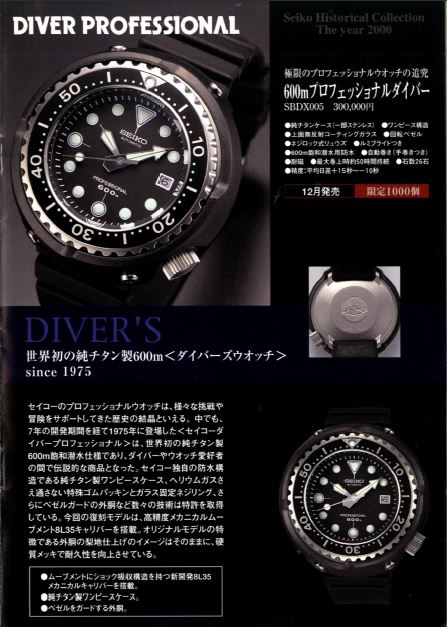
Similar to the first watch discussed in this post, everyone will be familiar with the SBDX011 (otherwise known as the Emperor Tuna, due to its size and heft) which is the non limited edition variant of this release, which is itself a descendant from the 36,000 bph 61 cal powered shrouded diver. The modern SBXD011 boasts 1000m of WR compared to this model’s 600M WR.
Hopefully this brings the Seiko Historical Collection The Year 2000 back in the consciousness of Seiko lovers worldwide.
Seiko Historical Collection the year 2000
Sharing some additional information about the other models in the Collection
